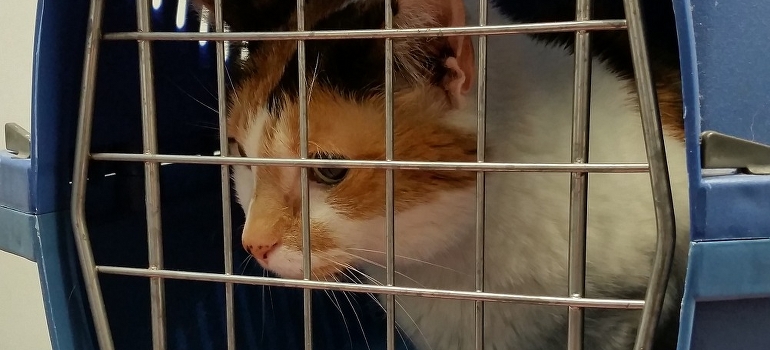Guide to Moving Abroad With Cats
Unlike dogs, cats are territorial animals that thrive on routine and familiarity. The idea of uprooting them from their comfortable environment and taking them on a long journey—whether by plane, car, or even ship—can be taxing. However, with careful planning, you can ensure a smooth transition for your feline friend. For U.S. residents moving internationally, pet travel regulations, airline policies, and quarantine laws vary by country. Without the right preparation, unexpected hurdles could delay your move—or worse, prevent your cat from entering your destination country. This guide by the best movers Seattle has will help you manage moving abroad with cats, from understanding travel rules to settling your cat into their new home overseas.
Researching Your Destination’s Pet Travel Rules
Before you start packing, the first step is understanding the pet import regulations of your new country. Some destinations welcome pets with minimal restrictions, while others have stringent health and quarantine requirements. Failing to comply with these rules can lead to denied entry, long quarantine stays, or even the heartbreaking possibility of your cat being sent back.
Entry Requirements
Every country has different rules about bringing in pets. Some require specific vaccinations, while others have additional health tests to ensure animals are disease-free. Common entry requirements include:
- Rabies Vaccination – Many countries require proof that your cat is vaccinated against rabies. Some demand that this vaccination be administered at least 21 to 30 days before entry.
- Rabies Titer Test – A blood test proving that your cat has sufficient rabies antibodies is required by nations like Japan, Australia, and the United Kingdom. The test often needs to be done months in advance.
- Parasite Treatments – Certain countries, such as the UK, require proof that your cat has been treated for parasites like tapeworms within a specified timeframe before travel.
- Microchip Identification – Many nations mandate that pets be microchipped with an ISO-compliant chip before travel.
However, not all microchips are universally recognized, so checking whether your cat’s chip complies with your destination’s standards is essential.

Quarantine Regulations
One of the biggest concerns for pet owners moving abroad with cats and their home with international movers Seattle offers is—quarantine. Some countries, especially those with strict biosecurity laws, impose mandatory quarantine periods upon arrival:
- No Quarantine – Countries like Canada, Mexico, and many EU nations allow pets to enter without quarantine, provided they meet all vaccination and health requirements.
- Short Quarantine (7-10 days) – Places like Hong Kong and Singapore require a short quarantine period even if all documents are in order.
- Extended Quarantine (Up to 6 months) – Australia, New Zealand, and certain island nations have strict biosecurity policies, requiring up to 30 days or more in quarantine unless your cat has met stringent pre-travel requirements.
The purpose of these policies is to prevent the introduction of diseases, but they can be stressful for pets. If you’re moving to a country with quarantine laws, preparing your cat in advance and ensuring they have a comfortable and familiar travel crate will help minimize anxiety.
Restricted Breeds and Banned Pets
While uncommon for cats, some destinations restrict certain breeds—particularly hybrid breeds with wild ancestry, such as:
- Savannah Cats (F1-F4 generations)
- Bengals (Early generation hybrids)
These breeds may require additional permits or be outright banned due to concerns about their impact on local wildlife. Always check with your destination country’s regulations before making plans.
Choosing the Right Travel Method
For most international moves, air travel is the only viable option. However, while your belongings travel with shipping companies Seattle offers, land or sea travel may also be consideration for you and your cats. Each method of moving abroad with cats has its pros and cons, and choosing the best one depends on factors like distance, your cat’s temperament, and airline policies.
Air Travel: Cabin vs. Cargo
For air travel, pet owners need to decide between cabin and cargo transport. Some airlines allow small cats to travel in the cabin if their carrier fits under the seat in front of you, which is the least stressful option since you can monitor and comfort them throughout the flight. However, many airlines have strict limits on in-cabin pets, so it’s important to check policies early and book accordingly.
If your cat is too large or if your airline doesn’t permit pets in the cabin, they will have to travel in the cargo hold. While this may sound concerning, many airlines have climate-controlled pet cargo areas designed for safe transport. Still, this option can be stressful for anxious cats, so preparing them in advance with crate training is essential.

Land and Sea Travel Considerations
Driving can be an option for those moving to nearby countries like Canada or Mexico. You can book international shipping companies Seattle for your items and then choose to drive to your destination. A long road trip requires planning for frequent breaks, securing your cat in a comfortable travel carrier, and ensuring they have food, water, and a litter box available.
Some ferries and cruise ships also allow pets, but these options are far more limited. The Queen Mary 2, for example, is one of the few ocean liners that provide pet accommodations, making it an option for transatlantic relocations.
Preparing Your Cat for the Move
Cats thrive on familiarity, so suddenly placing them in a travel carrier for a long trip can be overwhelming. The key to a successful move is gradual preparation.
Health Checkups and Vaccinations
Before traveling, schedule a comprehensive vet check-up. Ensure your cat:
- Is up to date on all vaccinations required by the destination country
- Is in good health for travel, especially if they’re elderly or have medical conditions
- Receives parasite treatments if required for entry
This is also a good time to discuss whether your cat might benefit from mild sedatives or calming aids during travel.
Microchipping and Identification
Microchipping is a lifesaver if your cat gets lost during transit. If your cat isn’t already microchipped, do it well before departure. Ensure the chip is ISO 11784/11785 compliant, as some countries only recognize certain microchip types. Additionally, attach a collar with an ID tag containing your contact information, including an email or international phone number.
Crate Training for Stress-Free Travel
A travel crate is your cat’s home during the journey, so they need to be comfortable in it. Follow these steps to make the carrier a safe space:
- Introduce the Crate Early – Leave it open in your home weeks before travel so your cat can explore it.
- Make It Cozy – Place familiar bedding, a favorite toy, and a piece of your clothing inside.
- Practice Short Trips – Take your cat on short car rides in the carrier to help them get used to the motion.
- Use Pheromone Sprays – Products like Feliway can help reduce stress.
With proper training, your cat will see their carrier as a safe place, reducing anxiety on travel day.
Paperwork and Documentation
One of the most stressful parts of moving abroad with cats is ensuring all paperwork is in order. Many countries require a veterinary health certificate issued within a specific timeframe before travel, often 10 days before departure. Some destinations also require the certificate to be endorsed by the USDA, which can add processing time. Keeping digital and physical copies of all documents—including vaccination records, import permits, and microchip registration—is crucial to avoiding last-minute problems.

Some countries require additional paperwork, such as import permits or advance notification of your pet’s arrival. For example, Japan requires pet owners to notify authorities at least 40 days before arrival, while the United Kingdom has strict requirements under the Pet Travel Scheme.
Booking Pet-Friendly Flights and Accommodations
Booking the right flight is one of the most critical aspects of moving abroad with cats. Not all airlines have pet-friendly policies, and even among those that do, there are differences in how pets are handled.
Whenever possible, book a direct flight to minimize travel time. Layovers can be stressful for cats, especially if they are traveling in cargo. Some airports are better equipped to handle pet transfers than others, so if a layover is unavoidable, research pet-friendly airports with designated animal care facilities.
Extreme weather is another factor to consider. Many airlines restrict pet travel in hot summer months or freezing winter conditions, so choosing a mild-weather season can reduce risks. If you’re not moving directly into your permanent home, you’ll need a pet-friendly hotel or rental.
Many hotels have strict policies regarding pets, with some allowing cats only in specific rooms or charging additional fees. It’s a good idea to confirm pet policies in advance and book a room where your cat will have a quiet, comfortable space to relax after a long journey.
Travel Day: What to Expect
The day of travel can be stressful, but good preparation and HB move management for your belongings will help things go smoothly. Before leaving for the airport, double-check that you have all necessary documents easily accessible, including health certificates, vaccination records, and import permits.
Airlines may ask for these at check-in, and customs officials at your destination will likely require them upon arrival. Ensure your cat’s carrier is comfortable with soft bedding, familiar scents, and ventilation. If your cat is traveling in cargo, attach a clear label with your contact information and a note stating that a live animal is inside.
Airport Procedures
Arrive at the airport early to allow enough time for security and check-in procedures. If your cat is traveling in the cabin, you may need to remove them from their carrier briefly at security while the carrier is scanned. Have a secure harness or leash ready to prevent escape. Stay calm and reassuring, as your cat will pick up on your emotions.
Managing Anxiety and Motion Sickness
Some cats handle travel well, while others may experience anxiety or motion sickness. If your cat is prone to stress, consider using pheromone sprays like Feliway to create a calming effect inside their carrier. Avoid sedatives unless recommended by a vet, as they can affect breathing at high altitudes. Instead, try natural calming methods such as placing a worn t-shirt inside the carrier to provide a comforting scent.

Common Challenges and How to Overcome Them
If your cat is traveling in cargo and your flight is delayed or baggage is misplaced, contact the airline’s pet transport department immediately. Many airports have pet care facilities where animals are held temporarily if flights are disrupted. Keeping a small carry-on bag with essentials (food, water, and a copy of documents) while moving abroad with cats can help you manage unexpected delays.
Pet Refusal at Customs
If customs officials deny entry for your cat due to missing paperwork or incorrect vaccinations, they may place them in temporary quarantine or, in extreme cases, require them to be returned to their home country. To avoid this, double-check all entry requirements well in advance and carry multiple copies of all documentation. If an issue arises, remain calm and work with officials to find a solution.
Behavioral Changes After the Move
IIt’s common for cats to act differently after a major move. Some may become withdrawn, hide for days, or exhibit changes in appetite and litter box habits. Creating a calm, familiar space and using gentle reassurance can help them adjust. One trick that often works? Boxes!
Cats love boxes, and after a big move, the stacks of your Seattle moving boxes in your new home might just become their favorite hiding spots. Let them claim a box or two as their own—it’s a simple way to give them a sense of security in an unfamiliar place. If your cat refuses to eat for more than 48 hours or shows signs of severe stress, consult a vet for advice.
Ensuring a Smooth Transition for Your Cat
Moving abroad with a cat requires careful planning and patience, but with the right approach, it can be a smooth experience. From understanding import regulations to preparing for the travel day and helping your cat settle in, each step plays a vital role in ensuring their comfort and safety.
Choosing pet-friendly travel options, preparing all necessary paperwork, and creating a stress-free arrival environment, helps your feline companion adapt to their new home with minimal anxiety.
A successful international move isn’t just about logistics of moving abroad with cats—it’s about making sure your pets feel safe, secure, and loved. With time, patience, and routine, they’ll soon settle into their new surroundings, ready to start this exciting new chapter with you.
Why Choose Us
History
Hansen Bros. Moving & Storage is locally owned and operated by the same family for four generations, since 1890. We have a well-established reputation for service quality and reliability with a high percentage of repeat household and commercial clients.
Professionalism
We’re a certified ProMover by the American Moving and Storage Association with A+ rating with the Better Business Bureau, voted “Best in Western Washington” in 2009 and from 2011 to 2016 by KING5. Our company is fully licensed and insured and member of WMC and AMSA.
Value
Hansen Bros. Moving & Storage provide free, no-obligation in-home estimate and competitive rates, including low minimum rates for shipments moving under 300 miles. We’ve set a refund policy for unused packing materials and three Puget Sound locations to help clients save on travel fee costs.



